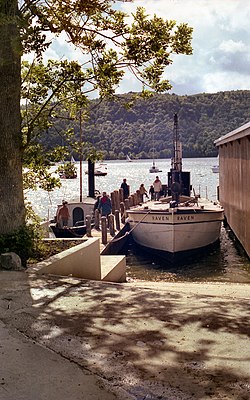
A steamboat is a boat that is propelled primarily by steam power, typically driving propellers or paddlewheels. Steamboats sometimes use the prefix designation SS, S.S. or S/S or PS ; however, these designations are most often used for steamships.

Windermere is the largest natural lake in England. More than 11 miles in length, and almost 1 mile at its widest, it is a ribbon lake formed in a glacial trough after the retreat of ice at the start of the current interglacial period. It has been one of the country's most popular places for holidays and summer homes since the arrival of the Kendal and Windermere Railway's branch line in 1847. Historically forming part of the border between Lancashire and Westmorland, it is now within the county of Cumbria and the Lake District National Park.

A paddle steamer is a steamship or steamboat powered by a steam engine that drives paddle wheels to propel the craft through the water. In antiquity, paddle wheelers followed the development of poles, oars and sails, where the first uses were wheelers driven by animals or humans.

PS Kingswear Castle is a steamship. She is a coal-fired river paddle steamer, dating from 1924 with engines from 1904. After running summer excursions on the River Medway and the Thames for many years she returned to the River Dart in Devon in December 2012 to run excursions from 2013 onwards on the river she was built on and for. Kingswear Castle is listed as part of the National Historic Fleet of ships of "Pre-eminent National Significance".

RMS Segwun is the oldest operating steam driven vessel in North America, built in 1887 as Nipissing to cruise the Muskoka Lakes in the Muskoka, Ontario, Canada, a resort area with many lakes and rivers. Early in the 20th century, Muskoka was poorly served by roads. Vacationers were transported to lodges, or private cottages, via a fleet of steamships. Segwun is one of only three ships in the world still carrying the status of Royal Mail Ship.

The steamship Virginia V is one of two last operational examples of Puget Sound Mosquito Fleet steamers. She was once part of a large fleet of small passenger and freight carrying ships that linked the islands and ports of Puget Sound in Washington state in the late 19th and early 20th centuries. She is a Seattle landmark and a National Historic Landmark.
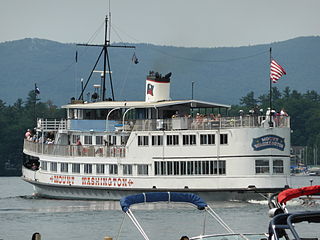
The MS Mount Washington is the flagship vessel of the Winnipesaukee Flagship Corporation. Its home port is on Lake Winnipesaukee in Laconia, New Hampshire, in the United States. The historic ship makes several ports of call around the lake during her scenic cruises in the spring, summer and fall months. Ice-Out is declared when the Mount Washington can get to all of its ports of call.

The steamboat Ticonderoga is one of two remaining side-paddle-wheel passenger steamers with a vertical beam engine of the type that provided freight and passenger service on America's bays, lakes and rivers from the early 19th to the mid-20th centuries. Commissioned by the Champlain Transportation Company, Ticonderoga was built in 1906 at the Shelburne Shipyard in Shelburne, Vermont on Lake Champlain.

Natchez has been the name of several steamboats, and four naval vessels, each named after the city of Natchez, Mississippi or the Natchez people. The current one has been in operation since 1975. The previous Natchez were all operated in the nineteenth century, most by Captain Thomas P. Leathers. Each of the steamboats since Leathers' first had as its ensign a cotton bale between its stacks.

Bonnington was a sternwheel steamboat that ran on the Arrow Lakes in British Columbia from 1911 to 1931. Bonnington and two sisterships were the largest sternwheelers ever built in British Columbia. Bonnington was partially dismantled in the 1950s, and later sank, making the vessel the largest freshwater wreck site in British Columbia.

Windermere Jetty: Museum of Boats, Steam and Stories is a museum on the eastern shore of Windermere between Bowness-on-Windermere and the town of Windermere in Cumbria, England. It reopened in March 2019 after 12 years' closure and redevelopment work.
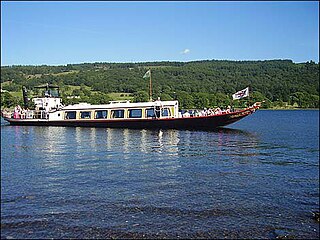
The steam yacht Gondola is a rebuilt Victorian, screw-propelled, steam-powered passenger vessel on Coniston Water, England. Originally launched in 1859, she was built for the steamer service carrying passengers from the Furness Railway and from the Coniston Railway. She was in commercial service until 1936 when she was retired, being converted to a houseboat in 1946. In 1979, by now derelict, she was given a new hull, engine, boiler and most of the superstructure. She is back in service as a passenger boat, still powered by steam and now operated by the National Trust.
Lake steamers of North America include large, steam-powered non-government vessels with displacement hulls on American freshwater lakes excluding the Great Lakes. They may have served as passenger boats, freighters, mail-boats, log-boom vessels or a combination thereof. The construction of such vessels posed unique problems on water bodies located away from established dry-docks and marine railways, or connecting canals to such facilities.

The MY Lady of the Lake is a passenger vessel operating for Ullswater 'Steamers' on the lake of Ullswater in the English Lake District, where she has spent her entire working life. She was built in 1877 as a steam vessel, but converted to diesel power in 1936. She is believed to be the oldest working passenger ferry in the world, and is a member of the National Historic Fleet.

The MY Raven is a passenger vessel operating for Ullswater 'Steamers' on the lake of Ullswater in the English Lake District, where she has spent her entire working life. She was built in 1889 as a steam vessel, but converted to diesel power in 1934. She is a member of the National Historic Fleet.

The SS Lakeland was an early steel-hulled Great Lakes freighter that sank on December 3, 1924, into 205 feet (62 m) of water on Lake Michigan near Sturgeon Bay, Door County, Wisconsin, United States, after she sprang a leak. On July 7, 2015, the wreck of the Lakeland was added to the National Register of Historic Places.
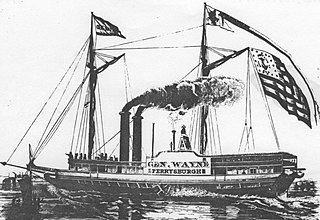
The PS Anthony Wayne was an early wooden-hulled sidewheel steamship that sank on April 28, 1850, in Lake Erie off the coast of Vermilion, Ohio, after two of her starboard side boilers exploded. The number of people onboard the ship at the time of incident is estimated to be about 100. The ship's clerk reported that there were 80 to 100 people on board, which included the crew, with about 30 of them surviving.

The SS Atlanta was a wooden hulled Great Lakes steamer that sank in Lake Michigan off the coast of Cedar Grove, Wisconsin, United States, after burning down. Her wreckage still remains at the bottom of the lake, and on November 6, 2017, the wreck of the Atlanta was listed on the National Register of Historic Places.

Windermere Lake Cruises is a boat company which provides leisure trips on Windermere in the central part of the English Lake District. It is based in Bowness-on-Windermere, Cumbria.
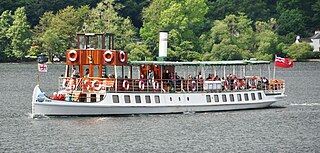
SY Tern, now operating as MY Tern, is a passenger vessel on Windermere, England. Launched in 1891 she was built for the steamer service carrying passengers from the Furness Railway. She underwent several changes in owner as companies were merged throughout the twentieth century, and spent time as a sea cadet training ship during the Second World War. Refitted several times, her original steam engines have been replaced with diesel engines. Tern is the oldest vessel operating on Windermere, and is a member of the National Historic Fleet. She is currently operated by Windermere Lake Cruises as the flagship of their fleet.
